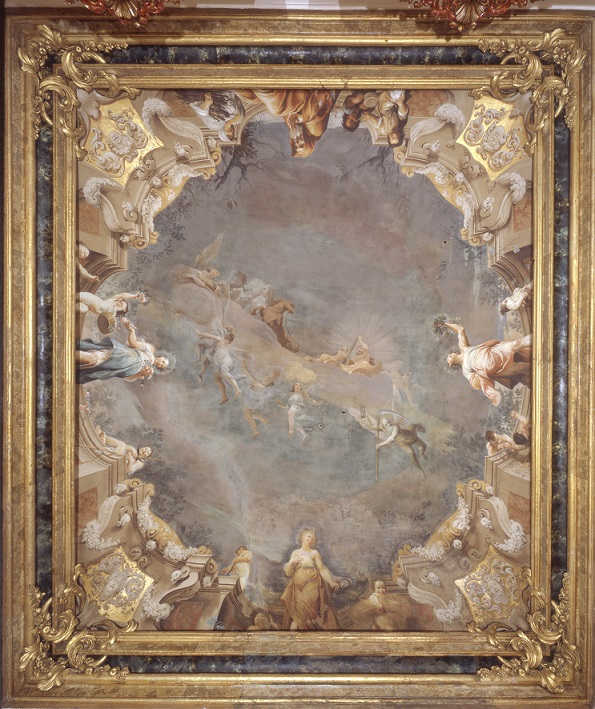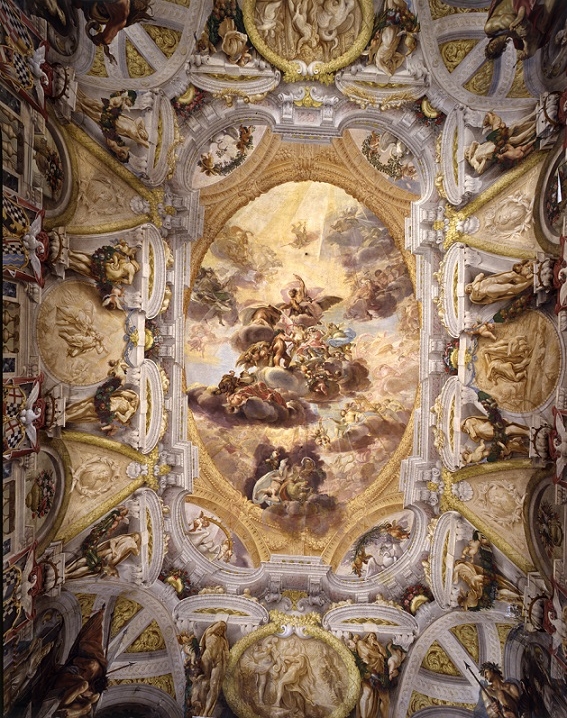- Details
- Category: Palazzo Pepoli Campogrande
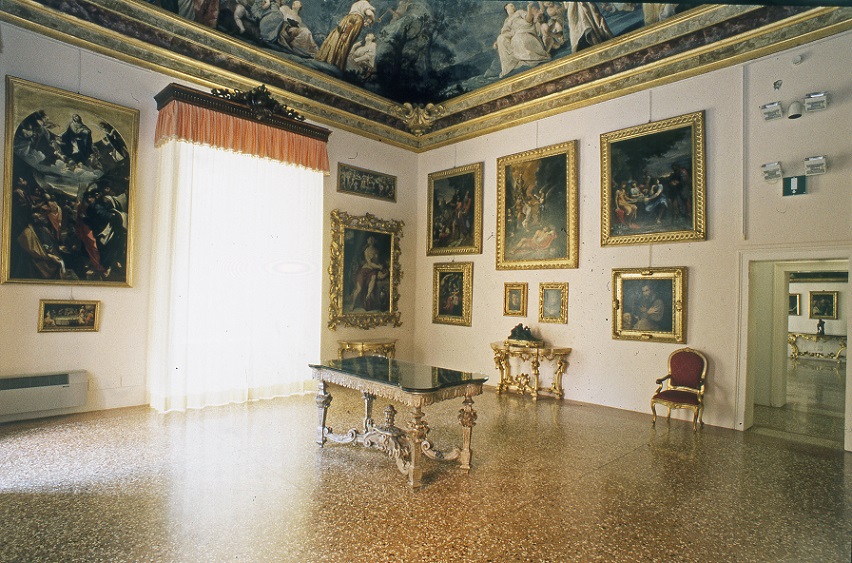
In the rooms of the main floor is exposed partially the "quadreria" Zambeccari, the ancient collection that the Zambeccari family, important noble family of the Bologna Senate, had assembled during the XVIIIth century in their family Palace near the San Paolo church (now occupied by the Banca Popolare di Milano, in via de’ Carbonesi 11). The collection entered in the Pinacoteca heritage in 1884, after the donation of the Marquess Giacomo Zambeccari that in his last will in 1788 had destinated the collection to the public enjoyment. The collection is compesed by more than 300 artworks and it is the only Bolognese aristocratic collection arrived to us in its entirety.
The pantings' subjects are varius: from religious and mythological scenes, up to still life and genre paintings. A main role is played by paintings of the bolognese and emilian school (almost an half of the collection) but there are even artworks of the Venetian, Genuan, Neapolitan, Tuscany, Lombardy and Roman, such as the Flamish schools.
The display is a reconstruction of that used in the ancient aristocratic collections, where the paintings were placed on the walls in several rows: it is not an exposition that presents the paintings well distanced and in chronological order, but a reproduction of the 1700's taste and style.
- Details
- Category: Palazzo Pepoli Campogrande
Totally different from the previous rooms, in which there is a collaboration between a figure painter and a quadraturista, here we have the work of a single artist, Giuseppe Maria Crespi, who worked here in the years around 1699-1700 . In the vault, the quadratura has a marginal role, being just a simple railing set on the real frame of the room, from which four figure are leading, carrying the traditional attributes of the Seasons. But their characterization has a strong popular flavour, so that it can be said that they seem more like peasants in disguise trying to draw our attention, more than refined allegorical figures.
The Spring, with a myrtle crown, has the hands full with flowers and laughs looking towards the center of the room, the Summer han a crown of wheat spikes and with a yellow dress, equally laughs with a mirror in her hand. Fall lift up his dress, showing a pair of robust legs ready to press the harvested grapes. Winter is depicted as an old man, trying to protect himslef from the cold near the fire, while some boys are playing with coarse humor.
At the center of the vault there is the Triumph of Hercules, central theme of the celebrative decoration, but that seems to be like a side show, confronted with the popular vibrancy of the Season figures. The triumphant hero is crossing the sky on a chariot, with a parade of Horae, represented as slender winged girls, opposed to Time, an old winged man with the scythe and the hourglass, falling down defeated by the now immortal Hercules.
- Details
- Category: Palazzo Pepoli Campogrande
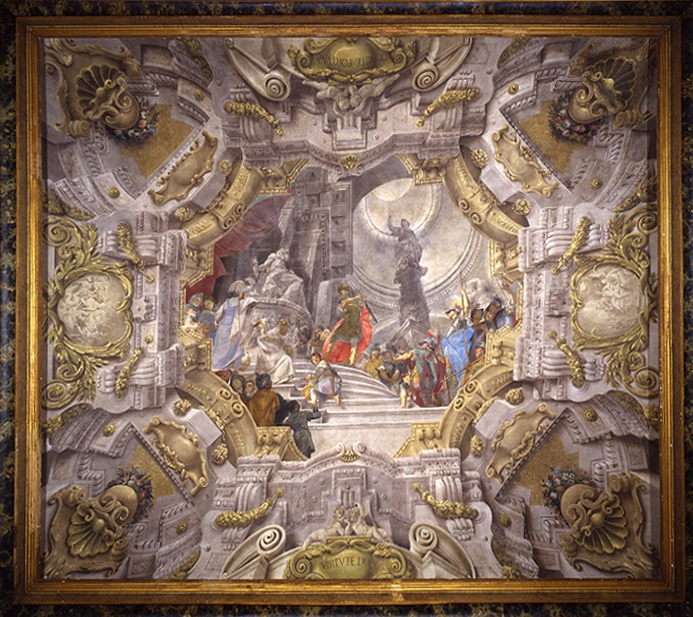
After the death of Ercole Pepoli, in 1707, it's Alessandro which takes care of the decoration works of the Palace, and it's him that in 1710 gives to Donato Creti the task of realize the fresco depicting Alexander the Great cutting the Gordian knot. Here the tradition of the "quadratura" is proposed with all its strenght, so that the scene frescoed by Creti is inserted in an exaggerate architecture by Marc’Antonio Chiarini that become the real protagonist of the painting.
Just like Ercole before him, even Alessandro Pepoli choose as subject a namesake, Alexander the Great. The depicted episode, taken from the ancient history, shows the Macedonian warrior entering in the city of Gordio, where it was preserved an ancient chariot of King Midas ancestors, tied with a knot that nobody was able to untie. According to an ancient prophecy, tha man able to untie that knot it would be the conqueror of the entire Asia, than Alexander, without losing time, break it with a silngle sword blow. The general is depicted at the center of the vault, stressed by his red cloak, in front of the chariot with a Jupiter statue on it, in the moment in which is to lash out with the sword. In the two golden ovals at the base of the vault are represented two episodes of Alexander's life: Alexander with his teacher Aristotles and Alexander overcoming Darius at the Isso battle.
Opposite to the vivid Crespi naturalism, here we face a rela "Rappel à l'ordre", with the rebirth of the illusionistic framing and the classical style of Creti, with his precise and refined design, totallt different from the liveliness and freshness of Crespi frescoes.
- Details
- Category: Palazzo Pepoli Campogrande
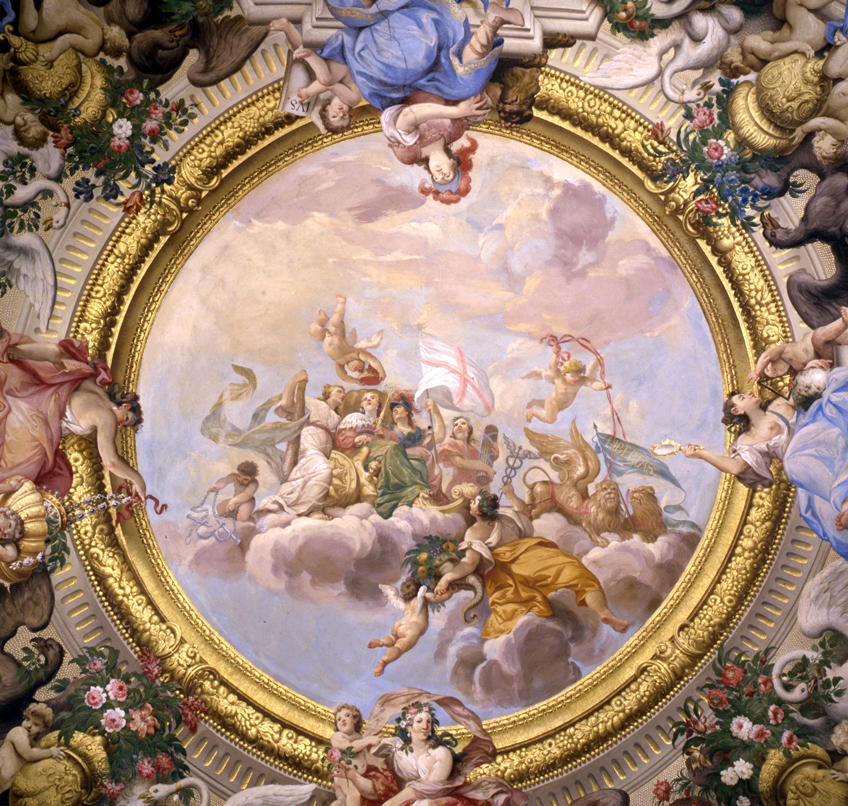
Odoardo Pepoli dies in 1680 and it's his nephew, Ercole, who takes charge for the Palace works. In 1683 he entered the Bologna Senate and from 1686 was created Patrician of Venice. This event is probably the subject of the fresco of the room adjacent to the Main Hall realised by the Rolli brothers in 1690. The Rolli, Canuti's pupils, were Giuseppe, author of the figures and Antonio, the "quadraturista". The depicted scene is the Triumph of Felsina ("Felsina" is the old, etruscan name of Bologna), an allegorical subject regarding the city of Bologna and his Government.
The young blond lady which gos on a chariot hauled by the Venice winged lions is the Bolognese Aristocracy, crowned by a putto with the red "corno", the headdress used by the Venetian Doges. At her side some handmaids carry on symbols of State Power: the Roman fasces, the Hercules club, the Bologna flag (white with a red cross and the writing LIBERTAS, "Freedom"), while a putto breaks the chains of the Pope domination. At the time Bologna had a mixed government, leaded by a Popo governor ("Legato") and by a local Senate, composed by some members of the town Aristocracy.
Below the chariot, the Public Happiness (with the Horn of Plenty and the Caduceus, symbol of Peace) shows to Felsina a young lady that can be interpreted as Love, for the rose in her hand, or the Pepoli House, for the araldic Swan on her sandals. The other female figures on the frame, among white swans and black eagles are completing the political meaning of the fresco, stressing the virtues of the Bolognese Aristocracy: The Justice (identified by the IUS (latin for Law) written on the book leading the Strenght, the Generosity, showing a necklace of precious black and white stones, and Science, with the mirror, the globe and the triangle.
- Details
- Category: Palazzo Pepoli Campogrande
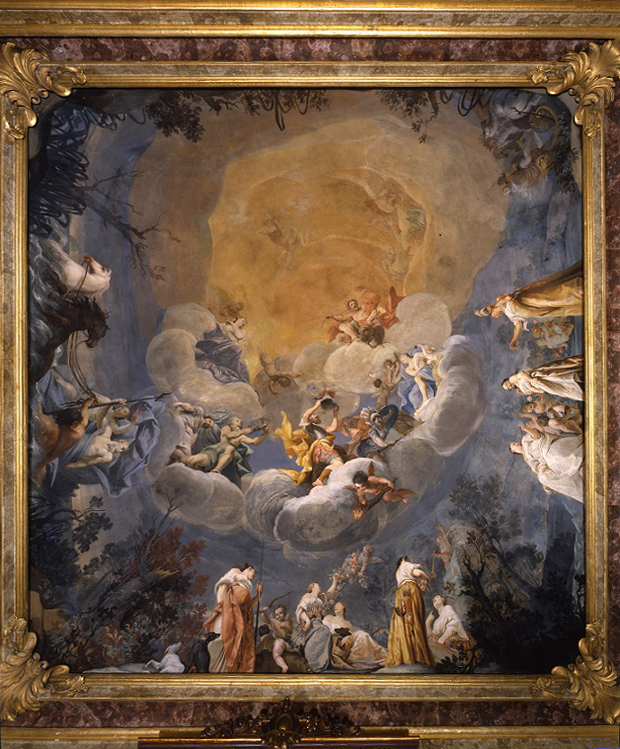
After the decoration of the Seasons Room, in the same period (1699-1700), Giuseppe Maria Crespi painted also the vault of this room, probably a bridal chamber.
Here the process of distanting from the Bolognese tradition of the "quadrature" frescoes is completed: there is no prospectical painted architecture and the vault is entirely occupied by a natural landscape. The set is a mix of both sea-side and woodland backgrounds, all played in refined grey tones that in the sky are lighted in orange and yellow hues. Crespi depicted the Olympus Gods: on the top the Sun Chariot, hauled by flying Apollo and Mercury. In the center of the valut, Jupiter and Juno and below them two sea Gods, maybe Thetis and Ocean, offering a chess shell to Jupiter. Then Mars taking off his helmet, Minerva with her armour, Love with a burning torch and Venus with the Pepoli's araldic swan sitting on her lap.
In the band just over the ledge we can see Neptun, the Sea God, hauled by two black and white horses, together with his wife Amphitrite, holding a branch of auspicious red coral; Diane and her nymphs, with their black and white dogs resting after an hunting party, while in a corner Pluto abducts Proserpine to take her in the Underworld. On the right, the Three Parcae (Clotho, Lachesis and Atropos), the goddesses that directed the human destiny remind us that the mithological fables, just as the earthly Fame, are beautiful but transitory, just like the soap bubble blowed by the kid in the background. Usually the three goddes are represented as ugly and old women, but here they are painted as thriving young ladies reminding the visitor how fleeting the human life is, hanging by a thred that Atropo, with her micking smile, is ready to cut.
- Details
- Category: Palazzo Pepoli Campogrande
The main hall was frescoed between 1669 and 1671 by Domenico Maria Canuti who, after the two ovals in the staircase made for Odoardo Pepoli, realised the large fresco with the Hercules Apotheosis together with the "quadraturista" (an expert specialising in pating the architectural scenes) Antonio Santi called the Mengazzino.
Hercules, the greek hero which was namesake of Odoardo's father and son, is depicted at the center of the vault being accepted in the Olympos by Jupiter, seated on an eagle at the presence of Eros and his wife Hebe, Goddess of Eternal Youth. Beside is Juno with her scepter and crown, while the other Gods are present in the shiny Sun chariot; under the hero, there are some allegorical figures, which represent virtues and vices; the Reason ruling the Strenght (a beast) and the Pride and Envy are the two women, the first young and beautiful, the other one older and with a greenish complexion, falling down. The scene is set in an open sky, beyond the rich "quadratura" (i.e. the architectural scene) painted by Mengazzino which expands the real architecture of the hall with a complex set of fake elements like ledges, banisters, arches, miches, columns and bas-reliefs, creating the illusion of the vault opening on an infinite space. The fake architecture is inhabited by atlantes supporting. In the four angles the are some nude giants (reminiscents of the famous Michelangelo's "ignudi" in the Sistine chapel). In the centre of each side the are four black and white ovals depicting some Hercules stories: Alcestis released from Ades, The Delphic Tripod Dispute, Hercules and the Cercopes, the Hesperides apples.
At the vault basis the Pepoli family coat-of-arms is coupled with that of various wifes of the family members, surmounted by a swan (one of the family symbols) and a metal crown (allusion at the title of Count received by the Odoardo branch). The coat-of-arms of the family is the black and white chessboard, which is reprised on the pavement, as a reference to the Family original occupation as moneychanger, the abacus chess being a medieval calculation instrument.

